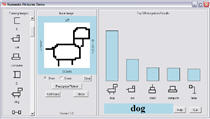 Some very smart people believe machines will take over — directing human affairs — sometime soon, perhaps within the next thirty years.
Some very smart people believe machines will take over — directing human affairs — sometime soon, perhaps within the next thirty years.
So much malarkey, you might think, until you consider the sorts of technologies being developed lately — some of which are starting to replicate human intelligence, one step at a time.
There’s Silicon Valley’s Numenta, the company started by Palm founder Jeff Hawkins, which is building a computer system that aims to think like the human brain. We’ve mentioned the company before, but Dean Takahashi, who starts writing for VentureBeat next week, provides an update about the fascinating company. Numenta’s software copies the human brain’s way of recognizing patterns with hierarchical memory (such as recognizing a dog shape; see image above and explanation here). Some 100 or so developers and eight companies are working to develop the software, and are applying it to several application areas, including visual object recognition and speaker voice identification.
It is the latter area, voice identification, that is seeing significant innovation — in part because of the booming mobile phone industry it serves. At the Mobile World Congress in Barcelona last week, another Silicon Valley company, Audience, emerged saying it has build a chip and software modeled that aims to function like the human ear in order to improve the sound quality of cellphones. It suppresses background noise by mimicking the human ear, which breaks down sounds into recognizable components of speech, and can thereby ignore other sources of sound. See the New York Times story about the Mountain View, Calif. company.
It was started by Lloyd Watts, a neuroscientist who studied with the physicist Carver Mead of Cal Tech. Paul Allen, a co-founder of Microsoft, along with several venture capital firms including New Enterprise Associates, have pumped in more than $22 million into the company, we’ve learned.
Forest Baskett, an investor at NEA, told VentureBeat that Audience blows away competing technologies. Incumbents include Forte Media, which uses technology that forms a beam in order to track your voice, but which can experience interference if background noise finds its way into the beam. There’s also Softmax, which uses multiple microphones, and assumes it can sort out which voice source to focus on, but can also breaks down in busy environments like airports, where you can have five to ten sound sources at any given time. Qualcomm recently bought Softmax.
Yesterday, another voice identification company Solicall, of Israel, emerged saying its sophisticated technology serves Windows Mobile, and beats existing sound identification technologies. SoliCall’s software focuses on the specific voice of the speaker, using a personalized filter that first learns your voice and afterwards, during any call, passes through only your voice and screens all other voices, noises and sounds. It’s based an algorithm for which the company has filed a patent.
These bite-sized developments, where technology starts to mimicking the human, aren’t doing it the centralized Frankenstein way, but from the edges, one step at a time.

